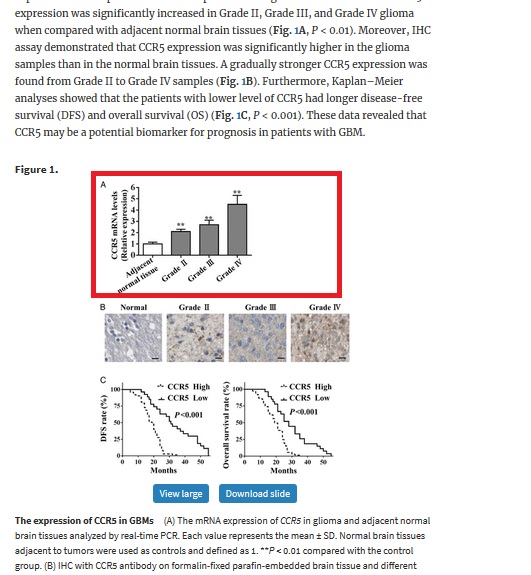(Total Views: 505)
Posted On: 06/01/2019 9:58:48 AM
Post# of 158169
Quote:
I need to go back and look at these two studies to see if they used regular cancer line, or metastatic cancer, ccr5 positive, etc. I believe it could make a difference with the results.
Read More: https://investorshangout.com/post/viewall?id=...z5pbQ2z9qf
https://academic.oup.com/abbs/article/47/11/890/1412
Critical roles of chemokine receptor CCR5 in regulating glioblastoma proliferation and invasion

Quote:
These data revealed that CCR5 may be a potential biomarker for prognosis in patients with GBM
This shows my thinking, the higher the tumor grade, the higher the ccr5 expression. So using cells with from the different grades could give different results in the mice studies. I would expect the higher the grade, the higher the ccr5 expression, the better the results with leronlimab.
This paper and the following two below sparked a new research idea, just published, what if you want the opposite to occur, where ccr5/ccl5 could be used as therapeutic to promote cell survival following for example irradiation injury.
Quote:
Since CCL5 can induce cell cycling in certain cancer systems (Zhao et al., 2015), we sought to determine whether CCL5 could promote cell cycling following irradiation
https://www.sciencedirect.com/science/article...3514006715
CCL5 promotes vascular endothelial growth factor expression and induces angiogenesis by down-regulating miR-199a in human chondrosarcoma cells
https://www.ncbi.nlm.nih.gov/pmc/articles/PMC5356747/
Cancer cell CCL5 mediates bone marrow independent angiogenesis in breast cancer
Quote:
It has recently been suggested that the chemokine receptor (CCR5) is required for bone marrow (BM) derived endothelial progenitor cell (EPC) mediated angiogenesis. Here we show that suppression of either cancer cell produced CCL5, or host CCR5 leads to distinctive vascular and tumor growth defects in breast cancer. Surprisingly, CCR5 restoration in the BM alone was not sufficient to rescue the wild type phenotype, suggesting that impaired tumor growth associated with inhibiting CCL5/CCR5 is not due to defects in EPC biology. Instead, to promote angiogenesis cancer cell CCL5 may signal directly to endothelium in the tumor-stroma. In support of this hypothesis, we have also shown: (i) that endothelial cell CCR5 levels increases in response to tumor-conditioned media; (ii) that the amount of CCR5+ tumor vasculature correlates with invasive grade; and (iii) that inhibition of CCL5/CCR5 signaling impairs endothelial cell migration, associated with a decrease in activation of mTOR/AKT pathway members. Finally, we show that treatment with CCR5 antagonist results in less vasculature, impaired tumor growth, reduced metastases and improved survival. Taken as a whole, this work demonstrates that directly inhibiting CCR5 expressing vasculature constitutes a novel strategy for inhibiting angiogenesis and blocking metastatic progression in breast cancer.
https://www.cell.com/stem-cell-reports/fullte...19)30145-6
CCR5 Signaling Promotes Murine and Human Hematopoietic Regeneration following Ionizing Radiation

Quote:
suggesting that CCL5 could play a role in hematopoietic regeneration following radiation injury
Quote:
suggests that CCR5 could be used as a marker or dosimeter for accidental radiation exposures.

